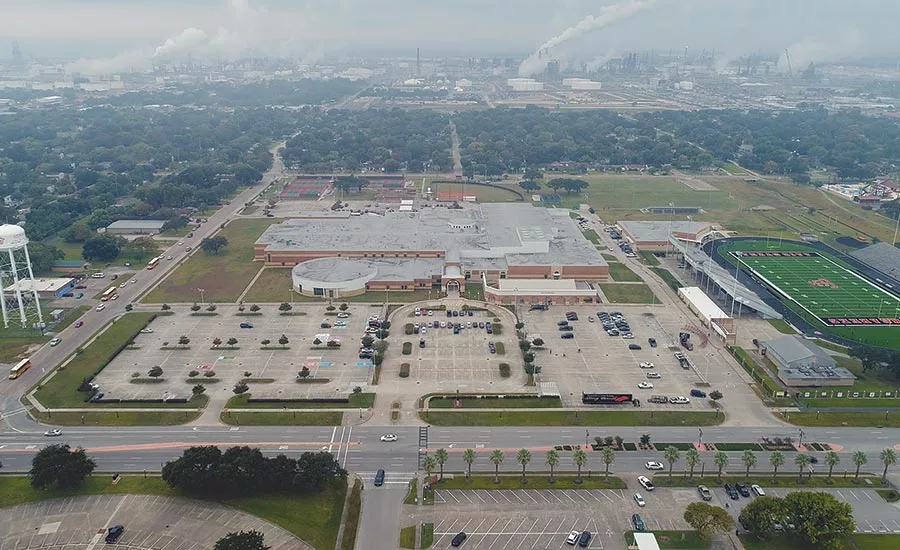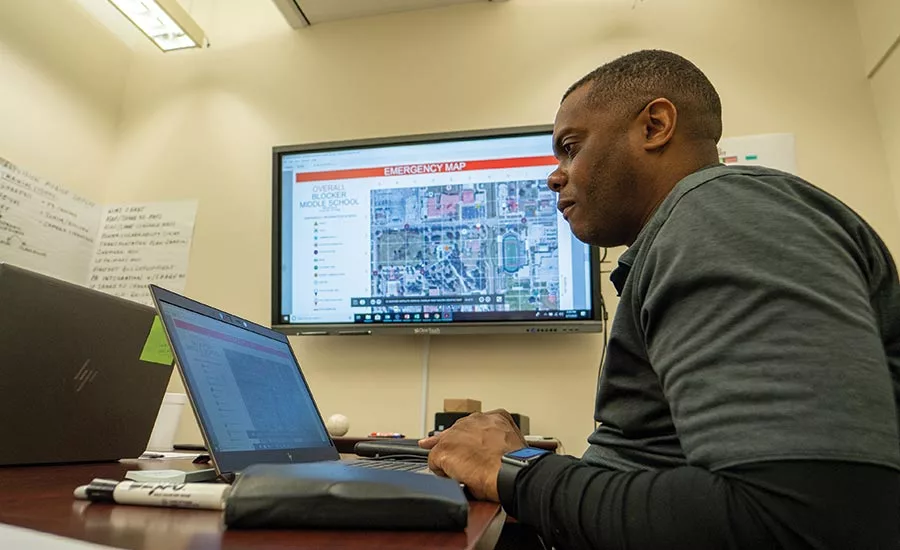Setting the Gold Standard in School Security
Mike Matranga at Texas City ISD is on a mission to become the safest school system in the nation, by arming guards, using facial recognition, bullet-resistant glass, tracking students with chip technology and employing mental health experts.

“There is a misconception that I’m too abrasive, and I don’t want that,” says Mike Matranga, Executive Director of Security and School Safety for Texas City ISD. “I'm just passionate about making a difference. We have done more in 18 months than any school district has done in 30 years. But I also want to get to a point where we can mend hearts and minds.”
Photo courtesy of Garrett Blucher

“There’s a misconception all we care about is an active shooter in our schools, but that couldn’t be further from the truth,” says Mike Matranga, Executive Director of Security and School Safety for Texas City ISD. “I’m really more concerned about a plant explosion or a student committing suicide.” Texas City ISD is surrounded by 19 major refineries that provide 13 percent of the nation’s oil.
Photo courtesy of Garrett Blucher

“Texas Senate Bill 11 was good, if it is enforced,” says Craig Shaw, Director of Security and School Safety. “There is talk about holding people accountable, but is a superintendent or a school board really going to be removed if a school isn’t in compliance?”
Photo courtesy of Garrett Blucher

“When I got here there was a need to see results right away,” says Mike Matranga, Executive Director of Security and School Safety for Texas City ISD, shown with Craig Shaw, Director of Security and School Safety. “I had to work backwards. I had to implement technology and hardening techniques first. Now I am writing the policy. I also want a licensed psychologist on my team. That is where we will see real results. We have school counselors, but the majority of them are not certified in mental health, and they are mainly doing academic counseling,” he says.
Photo courtesy of Garrett Blucher
Mike Matranga is on a mission to create the safest school system in the nation, through security technology and mental health experts to develop a robust, social emotional learning program.
Mike Matranga has been labeled brash, tough, outspoken, emotional and controversial. But when it comes to school security, he doesn’t care what people think of him. He is 100 percent undeterred by anyone who may question his methods when it comes to keeping schools and students safe.
Matranga, who is the Executive Director of Security and School Safety for Texas City Independent School District (ISD), says, “I know I have made some people angry with some of my comments. But here’s my take: My passion for doing the right thing is sometimes misunderstood. We continue to see the same tactics, techniques and procedures being used over the last 30 years and quite frankly, they are not working. Those methods were developed for a different problem, in a different time period in history. The challenges we face today are derived from the society we live in, which is degrading daily. Our kids face insurmountable scrutiny due to things such as social media, which judges them on how many ‘likes’ they have rather than who they are. We must have responsible dialogue and understand that the old reactive techniques of school security do not work. We must face challenges head-on; not cave to political correctness; always put students and staff first; deploy proactive measures, such as social media monitoring; and understand the behavioral health aspect to this nationwide problem.”
Texas City ISD
Texas City ISD is a public school district based in Texas City, Texas. It serves 9,000 students from Texas City and La Marque, as well as a portion of Tiki Island.
Matranga was hired three days after the May 18, 2018, shooting at Santa Fe High School, which left eight students and two teachers dead, as well as 13 wounded. Texas City ISD is only 15 miles from that school.
With the support of Texas City ISD Superintendent Dr. Rodney Cavness, Matranga, who is a decorated former U.S. Secret Service agent, has forged a new path for school security, one that some say is not always politically correct, but is one that many school districts are looking at as model on which to base school security. Matranga has taken things further than any other Texas school district to mitigate security threats, harden buildings, put more “boots on the ground” and improve student mental health.
In addition to the vision from Dr. Cavness, Matranga was also given a $6.5 million bond that he has used to build an experienced security team, one like no other. Before Matranga, Texas City ISD didn’t have a security team in place – the Galveston County Sheriff Department handled it. Since Matranga has arrived at Texas City ISD, he has established clear lines and expectations of what the school liaison deputies are responsible for and what school administrators are responsible for. Matranga says, “Too often, I’ve witnessed other districts who have their own police departments, and it isn’t always clear if the officers are following the authority bestowed upon them by state law or the wishes of the school board and superintendent. I find that to be unsettling, and at times, what prevents good intentions on behalf of the security team. I feel we have the best scenario here at Texas City ISD. It’s my job to be a good steward of both the deputies and the district.”
Immediately upon arrival at Texas City ISD, Matranga got to work. He hired Craig Straw as Director of Security and School Safety. Straw is the former school security director for Clear Creek ISD in League City, Texas. In addition to his school security experience, Straw served 27 years in the United States Air Force as a chief master sergeant and combat veteran. He is highly skilled and trained in security, contingency and global emergency management response.
Dilan Goodwin, Security Systems Analyst, and Joe Byrd, Technical Security Officer, both former U.S. Army IT Systems and Intelligence-based IT Analysts, were also brought on board. Byrd and Goodwin are what Matranga says are, “The key to managing the vast amount of security technology that has been implemented in the past 18 months. Quite frankly, they could possibly be the most important aspect of our plan.”
Matranga also has 19 Galveston County Sheriff’s Deputies who work as school liaison officers. One is Lt. Brent Cooley, who is the 2019, 100 Club Officer of the Year, a title that he earned due to his acts of courage and leadership exhibited during the Santa Fe High School shooting. Lt. Cooley, who is the Assistant Division Commander for the Galveston County Sheriff’s Office, School Liaison Division, was hired by Matranga prior to the 2018-2019 school year, due to his experience in law enforcement and his actions in Santa Fe. Matranga and Cooley provide a great balance to school-based law enforcement and security, and both understand the value and importance of a “holistic approach.”
Security Technology
The security technology employed at Texas City ISD includes $5.5 million for a robust camera and access control system by Avigilon; biometric facial recognition software by AnyVision; mass notification and emergency management systems that adopt the Standard Response Protocols from Share911; secure vestibule entries at every school with push button controls; AR-15s issued to all deputies with vault storage on campus; an anonymous reporting app by P3 Campus; and FirstNet AT&T for all administrators, law enforcement, crossing guards, campus safety monitors and school bus drivers to ensure essential personnel are able to communicate across district lines in the event of a crisis.
Matranga says that when he arrived, there was no actual thought given to how certain security systems may integrate and an inconsistency in the selection of security products. “It appeared the district awarded work to the lowest bidder and not always the best available,” he says. “Things such as integration of some systems from campus to campus were not considered at the time of the bid and therefore, there was a hodgepodge of systems.” Since then he has streamlined all of the systems and has chosen one integrator – ASAP Security Services of Houston – who primarily does all of the work for Texas City ISD to ensure the systems deployed all communicate with each other.
The new facial recognition system allows Matranga and Straw to see suspicious people or actions and track an individual’s movements, but also, to tell when someone’s on campus who shouldn’t be. The system worked last year, during the Texas City High School graduation, when it flagged an individual who had been banned from school activities. Matranga and Straw were quickly able to remove the individual from the event, using a multi-layered approach by first using the software to alert, and then by receiving positive confirmation by having three individuals confirm it was the person of interest. The individual was escorted out of the event without incident.
Matranga dismisses concerns from individuals who may question privacy issues with the facial recognition system. “I don’t understand those concerns,” he says. “Your phone uses facial recognition. You trust Apple with a facial image, why would you not trust it with trusted physical security experts who have established ethical means and policies to identify and confirm one’s identity? Why is it different when it comes to the security of our kids?”
Matranga says he hasn’t gotten much opposition for supplying AR-15s to his liaison officers, which are equipped with suppressors and are kept at individual schools in gun safes. Matranga feels that, “Those who are entrusted with the responsibility of keeping our students and staff safe must be equally equipped with the same tools a potential attacker would use. It just makes the fight fair.” He believes having the suppressors on the weapons would allow the operator to focus on the target without the distraction of the sound created by firing a rifle in a closed environment. He also believes it would drastically reduce the amount of post-traumatic stress disorder that students could suffer from reducing the sound of gunfire. Matranga says, “All community and parental input is important, but too many districts rely on parents and committees to make their decisions for them.”
Other security technology that has been implemented within the last 18 months includes intrusion film on all classroom door windows, secure vestibule entrances, secure campus receptionist areas and the ability for receptionists to lock entrances with the press of a button. Classroom doors are now able to withstand 13,000 pounds of force with the addition of a product called TeacherLock.
All district staff now have an app provided by Share911 that is fully customizable to any district’s needs. Matranga uses the app as a Mass Notification System and Emergency Management platform and it is integrated with the Standard Response Protocol, which is Lockdown, Lockout, Shelter-in-Place, Evacuate and Hold. Along with the app, each teacher has the system installed on their desktop as a contingency to the mobile application. Once any standard response protoctol is initiated, the system immediately alerts all four local law enforcement authorities and sends staff a text message, email and desktop notification. Soon, the system will send an automated message over each school’s public address system.
One security technology that Matranga is especially excited about is the P3 Campus Anonymous Reporting app, where parents and students can anonymously provide tips about concerning behavior. He has established a good relationship with both Mainland Crime Stoppers and Galveston County Crime Stoppers, who reward anonymous tipsters who provide credible information. Then it’s Byrd’s job to gather intelligence from open sources, such as the information from the P3 app or from public social media posts, to assist school administrators or law enforcement with their investigations.
A K-9 team patrols parking lots to find drugs and vaping materials in cars, in addition to explosives. In addition, Matranga and his team have employed a drone over the district to take aerial photos for what they call a “Tactical Response Survey,” an emergency plan that includes identifying locations for triage areas, decontamination areas, emergency landing zones, media designation and a command post. Now, all 14 districts schools have a tactical response plan.
In conjunction with the security technology are threat assessment teams on every campus, per the Secret Service’s National Threat Assessment Center’s recommendations. The teams are trained in a threat assessment protocol to analyze risks, to assess and respond to threatening behavior, and more importantly, to document past behavior and identify patterns of a student who may be on the path to violence.
With all of the technology, Straw stresses, “We are not just about calling out kids for bad behavior and arresting them. We want kids to be in school to learn and to become good citizens. Our campuses look like other campuses, and the technology is not intrusive. There’s nothing that we have done here that has been too aggressive. We feel morally and legally responsible for every life that’s on campus, and we take that very seriously. We hold our oaths very true to our heart.”
Matranga adds, “I understand optics – you don’t want to come across as too heavy-handed; you want to have resources in place, but you don’t always need to see them. The only reason I took this job is because Dr. Rodney Cavness called me after spending a few days after the Santa Fe shooting and said, ‘I never want to experience that again.’ He was serious. If I did not have his support, this would never work.” Matranga believes it’s critical to have a superintendent and board who understand that perhaps they aren’t the best people to be establishing security plans and implementing them.
Straw points out that he and Matranga are also following Texas Senate Bill 11, as all Texas schools should be doing. Bill 11 was passed by the Texas Legislature in 2019, and addresses elements of Texas Governor Greg Abbott’s school safety action plan, as well as recommendations from both houses of the legislature. The bill created a school safety allotment, estimated at $9.72 per student, that must be used to improve school safety, including improvements to school infrastructure; use or installation of physical barriers; the purchase and maintenance of security technology; employment of school district peace officers, private security officers, and school marshals; collaboration with local law enforcement; school safety and security training and planning; and more. It also calls for each district to establish a threat assessment and safe and supportive school team for each campus; to notify parents about risks involving their children and to seek consent from parents before students undergo mental health screenings or receive mental health services; to conduct training for peace officers; and for school districts to offer mental health training and anti-bullying techniques.
“We have exceeded Senate Bill 11 requirements,” Straw notes. “So now it’s time to talk ‘Left of Bang’; to identify the pre-attack indicators that exist before a crime is committed with enough time to be proactive. We are trying to get ahead of the precursors of a student in crisis that often show up in a student’s grades and in their behavior in class.”
Matranga agrees. Solid mental health and social emotional learning in Texas City ISD is his next challenge, as he believes it will solve school security and safety challenges, versus solely relying upon security technology bells and whistles.
Mental Health
That’s why Matranga is pushing for funding to hire a licensed psychologist, who would head up a team of licensed mental health professionals that would be present in every school. “We’ve fixed the castle, the physical portion, now let’s take care of the mental health and behavioral issues,” he says.
Matranga points to the November 2019 Secret Service’s National Threat Assessment Center report that found that 93 percent of school shooters exhibited “concerning behavior.” According to the report, family mental health, abuse/neglect and more contributed to past school security attacks. Most attackers, the report says, had experienced psychological, behavioral, or developmental symptoms, such as depression, suicide, ADD/ADHD and negative home life factors.
“When I got here there was a need to see results right away,” he explains. “So I had to work backwards. I had to implement technology and hardening techniques first. Now I am writing the policy, that will be, at least should be, audited by the correct agency. I want a licensed psychologist on my team. That is where we will see real results. We have school counselors, but the majority of them are not certified in mental health, and they are mainly doing academic counseling,” he says.
“There’s a misconception that all we care about is an active shooter in our schools, and that couldn’t be further from the truth,” Matranga adds. “I’m really more concerned about a plant explosion or a student committing suicide.” (Texas City ISD is surrounded by 19 major refineries that provide 13 percent of the nation’s oil). “People who think solely having police on campus is going to solve their problems are wrong,” he says. “In the past, police have been used on campuses as a deterrent to a growing drug epidemic. We now face new challenges and new threats of violence like we’ve never seen. Though the need for police is absolutely crucial in the overall plan, people need to understand the difference between security and policing. School administrators and police must work together in understanding pre-attack behaviors, identifying them and having real solutions in place to thwart an attack or prevent a student from harming themselves. Without that, we are only treating the symptoms of mental health and behavioral issues and are ignoring the causes. Once we start addressing the causes, whether it’s environmental or socioeconomic, we will see real change.”
Like all schools, Matranga stresses that Texas City ISD has had its share of mental health issues with students. “I think there’s a lot emphasis put on infrastructure security by our legislators, which is fine, but we need to have mental health security. Facts say that we rarely have an outsider coming from outside to attack a school. The threat is from inside. I caused a controversy when I spoke at the Texas Senate last year, because I began my testimony by stating ‘The wolf is in the henhouse.’ But I’m angry and I’m frustrated, too, because people still see the solution as solely putting locks on doors. Yes, the wolf is in the henhouse. I am not going to apologize for that statement. Any person who intentionally enters a school and kills kids or teachers is a predator.”
“We also can’t depend on law enforcement to solve all of our problems,” Straw adds. “Law enforcement and security are not the same. So don’t put the burden on our law enforcement officers to try to solve this problem. Their function is reactionary. We as a district, as a community and a country should understand that being proactive is key.”
To date, Matranga has received pushback on hiring a licensed psychologist for his team. “The reason why we have the same problems since Columbine is that educators are unwilling to step aside and let professionals make decisions in regards to security,” Matranga explains. “Our entire team is truly comprised of security and military minded people. We are not educators, and we don’t pretend to be. I know I have agitated a lot of educators, which has never been my intent, but there are times where I don’t need a debate – I need people to trust my experience and judgement, because if we don’t get this right, people get hurt. My intent is for our community and parents to never have to worry if their child is safe in our schools. My team comes from a climate of accountability and a no-fail mentality. Mental health and social emotional learning is where we will win this fight. But some districts feel that adding mental health support or physical security measures sends the message to the community that they have a problem and protecting their brand is more important. It is that mentality that will make them regret not being prepared and proactive.”
“Really, it’s more than mental health,” Matranga adds. “Mental health assumes there’s a diagnosis. Not every kid that goes into a counselor’s office has a diagnosis, but they could be going through some tough times and they can’t cope, and that’s where we are missing the opportunity to engage them. Our generation is not understanding that our youth are exposed to more violence and things that are not age appropriate, and I don’t believe their brains are developed enough to understand there are consequences to their actions. We were blessed to have a community who passed a $6.5 million bond. But if I could have spent that money differently, it would have gone into treating students and families, and providing resources from a social services standpoint.”
Straw agrees, “We can draw up a threat assessment plan all day long for students. But who is caring for him after he’s been arrested or comes back to school after disciplinary actions? Who’s checking on him on a regular basis? We can fix the child. But if we fix the child and then put them back into the negative environment they came out of, we will get more of the same. We want to fix the family, the community and the child.”
Overall, Matranga and his team want to work with all interested parties to keep Texas City ISD students, faculty and staff safe. “For example, we are one of the first districts in the county to do a bell-to-bell no cellphone policy,” Matranga says. “I don’t want cellphones during instructional time or while kids are on campus, as they are a distraction and cause further problems among students, and I truly believe they have degraded our society. Our kids live in a society where their popularity is based upon a system of likes, shares or views. We have become a narcissistic society because of social media, and it is absolutely destroying our youth. This is a community problem to solve, just not security. It cannot solely fall upon educators to figure out. We are asking for the support of everyone, but mostly parents to be engaged with their kids.”
At the end of the day, Matranga stresses, “There is a misconception that I’m too abrasive, and I don’t want that perception. I’m just really passionate about making a difference. We have done more in 18 months than any school district has done in 30 years. But I also want to get to a point where we can mend hearts and minds.”
Looking for a reprint of this article?
From high-res PDFs to custom plaques, order your copy today!









